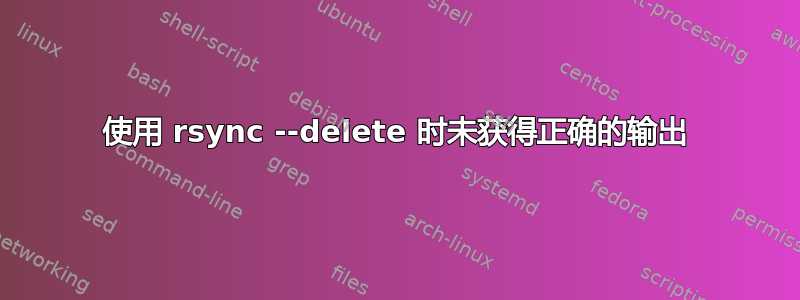
我正在尝试使用 rsync --delete 删除文件但我一直收到此输出。
答案1
rsync --delete
@sudodus 所以为了使用--delete 我必须从原始目录中删除原始文件?
是的,但是,我想说的是,其意图是相反的:当您删除了源中的相应文件时,它将帮助您删除目标中的文件。
如果您想避免复制某些文件(但将它们保留在源中),则可以使用--exclude。
rsync不是通用的删除工具。它是一个复制工具,用于复制/更新目标目录树,其中包含相应源目录树中的新文件或更新文件。选项--delete为“仅”同步,即如果源中的相应文件已被删除,则删除目标中的文件。
参见手册中的详细描述man rsync
--delete delete extraneous files from dest dirs
--delete-before receiver deletes before xfer, not during
--delete-during receiver deletes during the transfer
--delete-delay find deletions during, delete after
--delete-after receiver deletes after transfer, not during
--delete-excluded also delete excluded files from dest dirs
--ignore-missing-args ignore missing source args without error
--delete-missing-args delete missing source args from destination
--delete
This tells rsync to delete extraneous files from the receiving
side (ones that aren’t on the sending side), but only for the
directories that are being synchronized. You must have asked
rsync to send the whole directory (e.g. "dir" or "dir/") without
using a wildcard for the directory’s contents (e.g. "dir/*")
since the wildcard is expanded by the shell and rsync thus gets
a request to transfer individual files, not the files’ parent
directory. Files that are excluded from the transfer are also
excluded from being deleted unless you use the --delete-excluded
option or mark the rules as only matching on the sending side
(see the include/exclude modifiers in the FILTER RULES section).
Prior to rsync 2.6.7, this option would have no effect unless
--recursive was enabled. Beginning with 2.6.7, deletions will
also occur when --dirs (-d) is enabled, but only for directories
whose contents are being copied.
This option can be dangerous if used incorrectly! It is a very
good idea to first try a run using the --dry-run option (-n) to
see what files are going to be deleted.
If the sending side detects any I/O errors, then the deletion of
any files at the destination will be automatically disabled.
This is to prevent temporary filesystem failures (such as NFS
errors) on the sending side from causing a massive deletion of
files on the destination. You can override this with the
--ignore-errors option.
The --delete option may be combined with one of the
--delete-WHEN options without conflict, as well as
--delete-excluded. However, if none of the --delete-WHEN
options are specified, rsync will choose the --delete-during
algorithm when talking to rsync 3.0.0 or newer, and the
--delete-before algorithm when talking to an older rsync. See
also --delete-delay and --delete-after.
rm‘remove’ 是 Linux 的标准工具,用于删除文件别名
根据您的截图,您可以尝试
rm /tmp/backup/foto3.txt
或通过检查站确认,
rm -i /tmp/backup/foto3.txt


